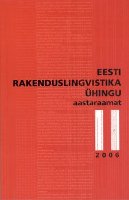Täis- ja osasihitise kasutamisest eesti keelt teise keelena õppijate pilgu läbi
On the use of total and partial object through the eyes of the learners of Estonian as L2
Author(s): Raili PoolSubject(s): Language and Literature Studies
Published by: Eesti Rakenduslingvistika Ühing (ERÜ)
Keywords: language learning; second language; introspection; object cases; Estonian language
Summary/Abstract: The informants of the study were 15 native Russian speakers who are students of Estonian as a foreign language and who speak Estonian fluently. The data originates from oral recordings, during which 7 sentences in Estonian were presented to the students, who were asked to use the appropriate object case (Nominative, Genitive or Partitive). They were also asked to explain the reasons of their choice. The choices and opinions of the subjects will be connected to the object usage of the Estonian grammar and the problems of teaching. Analysis of the empirical data shows that the informants who are linguistics students are able to exploit their knowledge when commenting their use of object cases. By questioning the students, it is therefore possible to obtain helpful information with which to compile teaching materials and plan tutoring. The questioning indicates that in the teaching of Estonian object cases, it is useful to consider the fact that Estonian transitive verbs are classified as partial and aspect verbs. When teaching Estonian it is important to emphasize that Estonian language doesn’t have constructs which invariably demand nominative objects (as objects of impersonal and imperative verbs are fixed in the knowledge of some language learners) but it is always possible to construct the use of the partitive object. In general, the subjects are characterized by a wish to follow the rules; apply of analogy, rely on intuition and draw parallels with L1 characterizes only individual subjects.
Journal: Eesti Rakenduslingvistika Ühingu aastaraamat
- Issue Year: 2006
- Issue No: 2
- Page Range: 185-202
- Page Count: 17
- Language: Estonian

